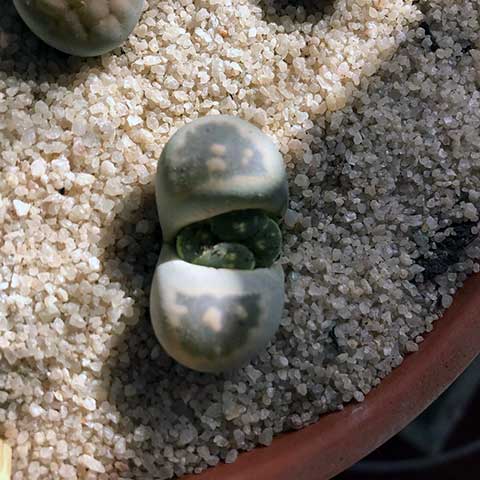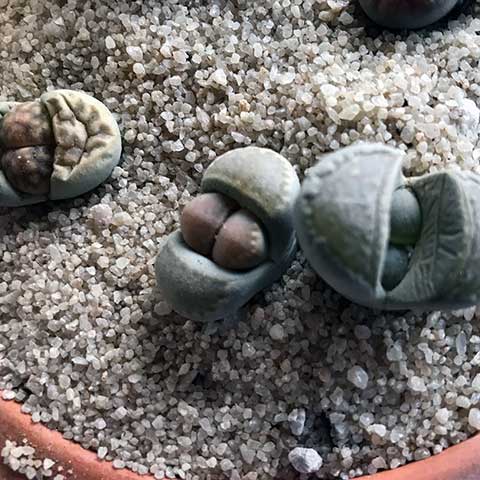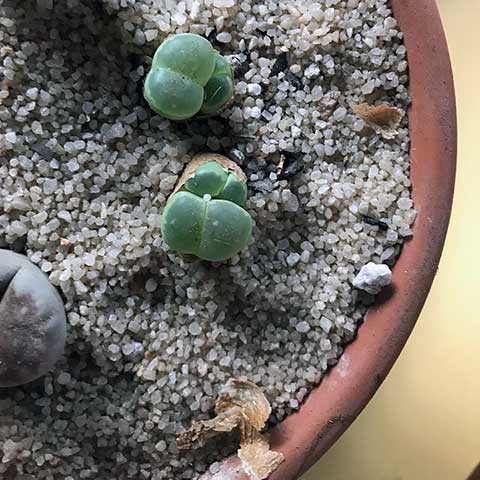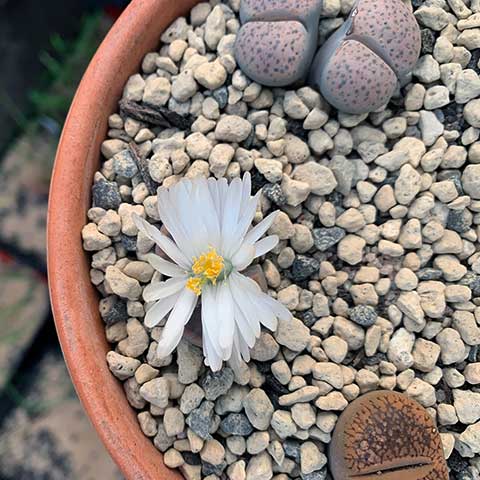spend R1000 & 2kg or less = free shipping.
Menu

spend R1000 & 2kg or less = free shipping.

Your Cart is Empty

4 min read
Article written by Marion Thompson
My journey with lithops started with a few given to me about two years ago. Thinking I could treat them as I did any standard succulent, I started out with supreme confidence. If there is one thing this plant will do, it is to humble you. Given that I live in an area about as far removed in climate from their natural habitat, that was pretty much always going to happen.

At that point I decided I needed to educate myself.
Lithops are small mimicry plants which are made up of two leaves which are fused together. These leaves are semi-translucent and the flattened top part operates as a window and is the means by which the plant receives the light it needs. They are found in areas of Southern Africa which are extremely dry and receive minimal rainfall. As a result of this, their capacity to store water is immense. They also sit close to the ground to protect them from the heat.
Lithops follow a very distinct annual cycle, and it is this which is the most important to understand. Having said this, different species do follow slightly different timelines.
By spring, the new leaves should be established, and the old leaves should be totally dry. The new leaves continue to grow and become established during this time.

In summer they become dormant. In their natural habitat this ensures they survive the hottest and driest time of the year. They require little to no water at this time and any water they receive will cause them to rot.
In autumn, they start to grow. The groove between the leaves will open up and a bud will emerge. In each case a single flower will appear. The flowers open during the afternoon and are mostly yellow and white. Lithops will only flower when they are between 3 and 5 years old. In nature, lithops will start flowering after the seasonal rains start, so the beginning of autumn is the time to start watering.
During winter, the plant continues to grow. At this time, the leaves will separate and start to shrivel, with new leaves growing from between the old leaves. The new leaves receive all their moisture and nutrients from the old leaves. In some cases, more than one set of new leaves will appear, and in this way lithops may form clumps. The leaves continue to dry until they are thin and papery. At this point, they can be removed.

It is very important to understand this life cycle and to ensure watering is appropriate to each stage. In my experience, this is where things go wrong with these plants.

For me, there are two critical issues to growing lithops.
The first is to understand the watering patterns and to work out how best to fit these into my own conditions. I live in an area with high summer humidity. In fact, we probably have higher levels of humidity all year round than lithops would find naturally. I have to work around this in working out how much to water. Summer is especially tricky as they do not want any water at this time and the environmental humidity can be significant.

The second consideration is choice of substrate. I started with far too much organic matter in my substrate and I lost a fair number of lithops to rot. This soil just did not dry out fast enough and lithops left sitting in moisture are prone to rot. I then started adding pool filter sand into my mix and this helped, but still wasn’t sufficient. I have now started using pumice, which is widely recommended for lithops and other succulents. I prepare a mix with 90/10 proportions. The 90% is made up of pumice and some filter sand. This mix allows me to provide different consistencies in the substrate. The 10% is made up of soil. The health of my lithops has shown a significant improvement since making the change and I face summer a little less afraid than I have previously.
These little plants can be frustrating and at times soul destroying. But when you get it right and are able to watch the leaf changes and the flowers appear, they are by far and away the most exhilarating plant to own.
March 28, 2023
Hi
Nice to have someone who really explains how to look after lithops.
I’ve been struggling for many years, without success.
Thanks
August 12, 2022
Hi Terry,
When is best to repot lithops? I bought one a week ago and it looks like it is potted in coco fiber which is probably the worst to use. Can i repot it now?
Comments will be approved before showing up.

Exclusive Offer: Buy 2 Venus Fly Traps, Get the 3rd One FREE - Limited Time Only!
Add three, six, nine or any other multiple of three of our hungry fly traps to your cart and the discount is automatically applied.
Carla
March 28, 2023
Is it possible to save one that started rotting at the base?